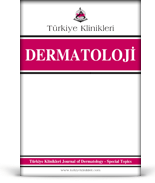Amaç: Seboreik dermatitli hastaların kendi hastalıklarını araştırmak ve tedavi seçenekleri aramak için sosyal medyayı ne sıklıkla kullandıklarını incelemek istedik. Bu tür küratif tedavisi olmayan cilt hastalıklarının sosyal medyada ve internette sıklıkla suistimal edildiğine inanıyoruz. Gereç ve Yöntemler: On altı soruluk bir anketi doldurmaları istenen katılımcılara 2 sayfalık anket verildi. Hastaların demografik bilgileri, hastalıklarının tedavisi ile ilgili güçlükleri, en çok kime güvendikleri, sosyal medya kullanımları, hangi sosyal medya kaynaklarını kullandıkları ve sosyal medya kullanımı sonrası hastalık şiddetindeki değişimler soruldu. Bulgular: En sık kullanılan sosyal medya platformu Instagram (%63,6) ve YouTube (%53) idi. Sosyal medya tavsiyelerinin ardından hastaların %35,2'si hastalığın şiddetinin değişmediğini ifade etti. Hastaların %43,9'u tedavi kılavuzuna uyumlu, %19,7'si uyumlu değildi. Hastaların %15,2'si kılavuza uydu ancak tavsiye edilmeyen yaşam tarzı değişikliklerini de uygulamıştı. Sonuç: Bu çalışma, seboreik dermatitli hastaların büyük çoğunluğunun hastalıklarının tedavisinden memnun olmadığını ve hastalıklarının tedavisini araştırmak için sosyal medyayı çok sık kullandıklarını göstermiştir. Dolayısıyla bu konuda elde edilecek veriler, profesyonellerin hastaları doğru yönlendirmek için sosyal medyayı daha etkin kullanmasını sağlayabilir ve hastaların uygunsuz tedavilerden ve yüksek tedavi maliyetlerinden korunmasına yardımcı olabilir.
Anahtar Kelimeler: Seboreik dermatit; sosyal medya; tedavi kılavuzları
Objective: We wanted to examine how often patients with seborrheic dermatitis use social media to investigate their own diseases and seek treatment options. We believe that such incurable skin diseases are often abused on social media and the internet. Material and Methods: The 2-page questionnaire was delivered to participants who were being asked to fill out a 16-question questionnaire. The demographic information of the patients, the difficulties associated with the treatment of their disease, who they trust the most, their use of social media, which social media resources they use, and the changes in the severity of their illness after social media use were questioned. Results: The most frequently used social media platform was Instagram (63.6%) and YouTube (53%). After the social media recommendations, 35.2% of the patients stated that the severity of the disease did not change. 43.9% of the patients were compatible with the treatment guideline, and 19.7% were not. 15.2% of the patients complied with the guideline but also applied non-recommended lifestyle changes. Conclusion: This study showed that the majority of patients with seborrheic dermatitis are unsatisfied with the treatment of their disease and use social media very often to investigate the treatment of their diseases. Therefore, the data to be obtained in this regard can enable professionals to use social media more effectively so as to direct patients correctly and help protect patients from inappropriate treatments and high treatment costs.
Keywords: Seborrheic dermatitis; social media; treatment guidelines
- Kamiński M, Tizek L, Zink A. 'Dr. Google, what is that on my skin?'-Internet searches related to skin problems: google trends data from 2004 to 2019. Int J Environ Res Public Health. 2021;18(5):2541. [Crossref] [PubMed] [PMC]
- DeBord LC, Patel V, Braun TL, Dao H Jr. Social media in dermatology: clinical relevance, academic value, and trends across platforms. J Dermatolog Treat. 2019;30(5):511-8. [Crossref] [PubMed]
- Clark GW, Pope SM, Jaboori KA. Diagnosis and treatment of seborrheic dermatitis. Am Fam Physician. 2015;91(3):185-90. [PubMed]
- Xuan M, Lu C, He Z. Clinical characteristics and quality of life in seborrheic dermatitis patients: a cross-sectional study in China. Health Qual Life Outcomes. 2020;18(1):308. [Crossref] [PubMed] [PMC]
- Urso B, Updyke KM, Domozych R, Solomon JA, Brooks I, Burton V, et al. Acne treatment: analysis of acne-related social media posts and the impact on patient care. Cutis. 2018;102(1):41-3. [PubMed]
- Cheong WK, Yeung CK, Torsekar RG, Suh DH, Ungpakorn R, Widaty S, et al. Treatment of seborrhoeic dermatitis in asia: a consensus guide. Skin Appendage Disord. 2016;1(4):187-96. [Crossref] [PubMed] [PMC]
- Costhelper H. How much does seborrheic dermatitis treatment cost. 2022. [Link]
- Micali G, Lacarrubba F, Dall'Oglio F, Tedeschi A, Dirschka T. A new proposed severity score for seborrheic dermatitis of the face: SEborrheic Dermatitis Area and Severity Index (SEDASI). Journal of the American Academy of Dermatology. 2017;76:AB18. [Crossref]
- Gantenbein L, Navarini AA, Maul LV, Brandt O, Mueller SM. Internet and social media use in dermatology patients: search behavior and impact on patient-physician relationship. Dermatol Ther. 2020;33(6):e14098. [Crossref] [PubMed]
- Del Rosso JQ. Adult seborrheic dermatitis: a status report on practical topical management. J Clin Aesthet Dermatol. 2011;4(5):32-8. [PubMed] [PMC]
- Borda LJ, Wikramanayake TC. Seborrheic dermatitis and dandruff: a comprehensive review. J Clin Investig Dermatol. 2015;3(2). [Crossref] [PubMed] [PMC]
- Sanders MGH, Pardo LM, Franco OH, Ginger RS, Nijsten T. Prevalence and determinants of seborrhoeic dermatitis in a middle-aged and elderly population: the Rotterdam Study. Br J Dermatol. 2018 178(1):148-53. [Crossref] [PubMed]
- Sanders MGH, Pardo LM, Ginger RS, Kiefte-de Jong JC, Nijsten T. Association between diet and seborrheic dermatitis: a cross-sectional study. J Invest Dermatol. 2019;139(1):108-14. [Crossref] [PubMed]
- Yousaf A, Hagen R, Delaney E, Davis S, Zinn Z. The influence of social media on acne treatment: a cross-sectional survey. Pediatr Dermatol. 2020;37(2):301-4. [Crossref] [PubMed] [PMC]
- Park JH, Christman MP, Linos E, Rieder EA. Dermatology on Instagram: an analysis of hashtags. J Drugs Dermatol. 2018;17(4):482-4. [PubMed] [PMC]







.: Process List